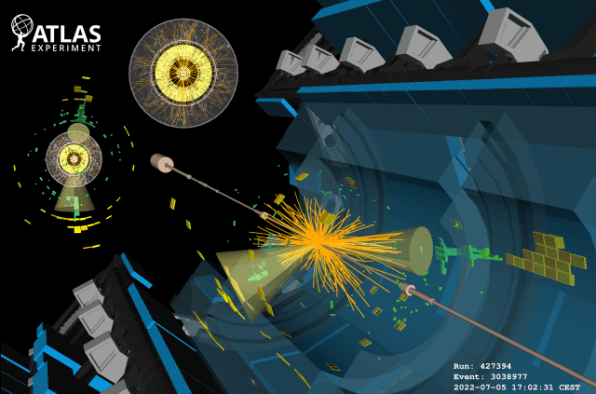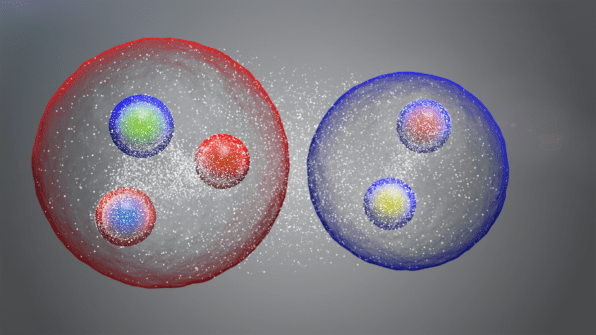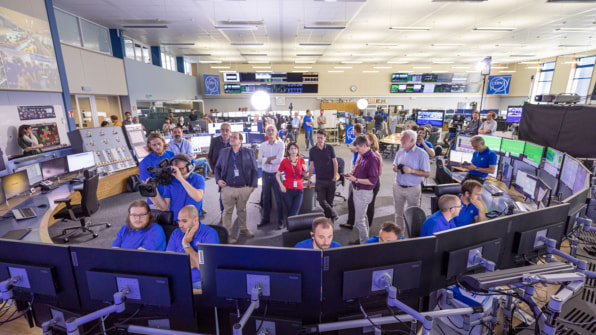

CERN particle accelerator results: What did scientists find?
source link: https://www.fastcompany.com/90766930/cern-large-hadron-collider-what-have-physicists-found-and-what-are-they-looking-for-next
Go to the source link to view the article. You can view the picture content, updated content and better typesetting reading experience. If the link is broken, please click the button below to view the snapshot at that time.

CERN Large Hadron Collider: What have physicists found and what are they looking for next?
The particle accelerator, newly fired up after a three-year hiatus, is even more powerful than before, further increasing the chance of new discoveries.
Physicists at the world’s largest atom collider have observed three new exotic particles as they continue to search for clues about the mysterious forces that bind subatomic particles together, they said on Tuesday.
The observation of the particles—a new type of pentaquark and the first duo of tetraquarks—came on a momentous day at CERN, the Geneva lab, which on Tuesday also fired up its Large Hadron Collider again, after a three-year hiatus, with the machine’s most powerful beam of energy yet.
This week also marks the the 10th anniversary of the confirmation of the Higgs boson, a milestone at CERN that helped to solidify the so-called Standard Model, which accounts for the basics of particle physics. The Higgs, named for the Nobel Prize-winning physicist who theorized it, helps give all matter its mass, and is thought to have been present at the creation of the universe, seconds after the Big Bang 13.7 billion years ago.
But physicists still have questions about the Higgs, and they’re looking beyond the Standard Model. It’s the most comprehensive one we have, but it doesn’t explain where gravity comes from, what dark matter is, or why there is so much more matter than antimatter in the universe.
Enter the LHC. Along its giant underground ring, stretching beneath a 27-kilometer, or 17-mile, circumference of countryside and across the Swiss-French border, a series of superconducting magnets help propel subatomic particles to near light speed in order to smash them together as powerfully as possible.
Explosive collisions, powerful results
In particle accelerators like this, slamming protons together at high energy can produce tiny fragments of the universe not normally seen. As in a car crash, where more explosive collisions result in smaller fragments, the higher the energy, the higher chance that the LHC’s detectors will be able to help researchers pick up traces of the tiniest, most exotic particles.

The particle beams wlll be denser too, further increasing the probability of a collision, and the chance of producing Higgs bosons, finding new particles, and perhaps new physics. Among the highly sought-after prizes is the axion, a particle thought to not emit, absorb, or reflect light. It’s one leading contender for the make-up of dark matter, the mysterious stuff that physicists think accounts for 85% of the matter in the universe.
The new particles
The first-ever pair of tetraquarks and the new pentaquark, discovered in torrents of data gathered during previous research at the LHC, will help explain how subatomic particles form. These particles, like the protons and neutrons that make up the nuclei of atoms, are known as hadrons, and the more exotic hadrons are made up of two or three elemental particles called quarks.

“We’re witnessing a period of discovery similar to the 1950s, when a ‘particle zoo’ of hadrons started being discovered and ultimately led to the quark model of conventional hadrons in the 1960s,” physicist Niels Tuning said in a statement. “We’re creating ‘particle zoo 2.0.'”
Specifically, the new findings will help theorists develop a unified model of exotic hadrons, and better understand conventional hadrons. While some theories describe exotic hadrons as “balls” of tightly bound quarks, other theoretical models imagine them as pairs of standard hadrons that are loosely bound in a molecule-like structure. More research is required to know if either or both theories are true.
The pentaquark finding has a whopping statistical significance of 15 standard deviations, way beyond the 5 standard deviations that are required by the physics community to claim the observation of a particle. The new tetraquarks, observed with a statistical significance of 6.5 and 8 standard deviations respectively, are the first time a pair of tetraquarks has been observed.
An international effort
More than 5,500 scientists from 245 institutes in over 40 countries work on the LHC’s largest experiment, ATLAS. Other new experiments at CERN probing the nature of the universe will focus on collisions of high-energy ions, to better understand the plasma that was present only in the first microsecond after the Big Bang; probe the insides of protons; study cosmic rays; and search for the still-hypothetical magnetic monopole, an isolated magnet with only one magnetic pole. Other detectors will help researchers study extremely light and weakly interacting particles, like neutrinos and dark matter.

The multibillion-euro project is funded by contributions from each participant country. For fiscal year 2022, the Biden administration initially allocated only $40 million for future upgrades at the LHC, well below the about $90 million needed. The Department of Energy subsequently diverted an additional $25 million from various other physics projects, including a set of upgrades at Fermilab, and the Biden administration is now requesting $85 million, the American Institute of Physics reported.
During this run, the researchers behind LHC’s two main experiments will collide bunches of around 100 billion protons at a rate of 40 million collisions per second, each one producing around 60 smashes, each of which will generate hundreds of particles.
“The more analyses we perform, the more kinds of exotic hadrons we find,” Tuning said.
Recommend
-
 63
63
-
 56
56
This marks the beginning of a week long adventure in Geneva Switzerland at CERN, to work on a hack project. The project...
-
 28
28
-
 31
31
This is more of a note for myself. Over time, I’ve learned some useful fact about ROOT that I now wish I have known when I started using ROOT. Hopefully as a ROOT user, you could also find some of these helpful. Tell ROOT to not s...
-
 11
11
Mostly want to document how I’m building ROOT on ARM64 Arch Linux. The process it quite trivial but in case I forgot how to do it in the future. My ARM server runs
-
 9
9
Particle seen switching between matter and antimatter at CERN ...
-
 15
15
Voir en français Environmental awareness: Tackling waste management at C...
-
 8
8
Did we discover a new force of nature? New results from CERN Results suggest beauty quarks decay into electrons and muons at different r...
-
 7
7
A particle accelerator is now colder than space to produce 1 million X-ray pulses a second
-
 4
4
Can a Particle Accelerator Trace the Origins of Printing?Movable metal type is often traced back to Gutenberg’s workshop, but its history is far older in Asia. Researchers are using atomic-scale tools t...
About Joyk
Aggregate valuable and interesting links.
Joyk means Joy of geeK